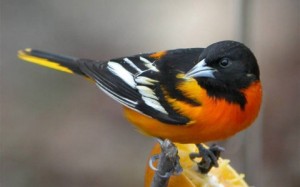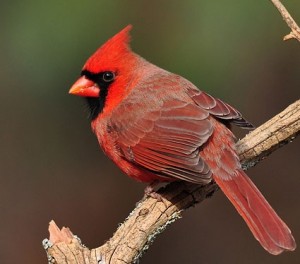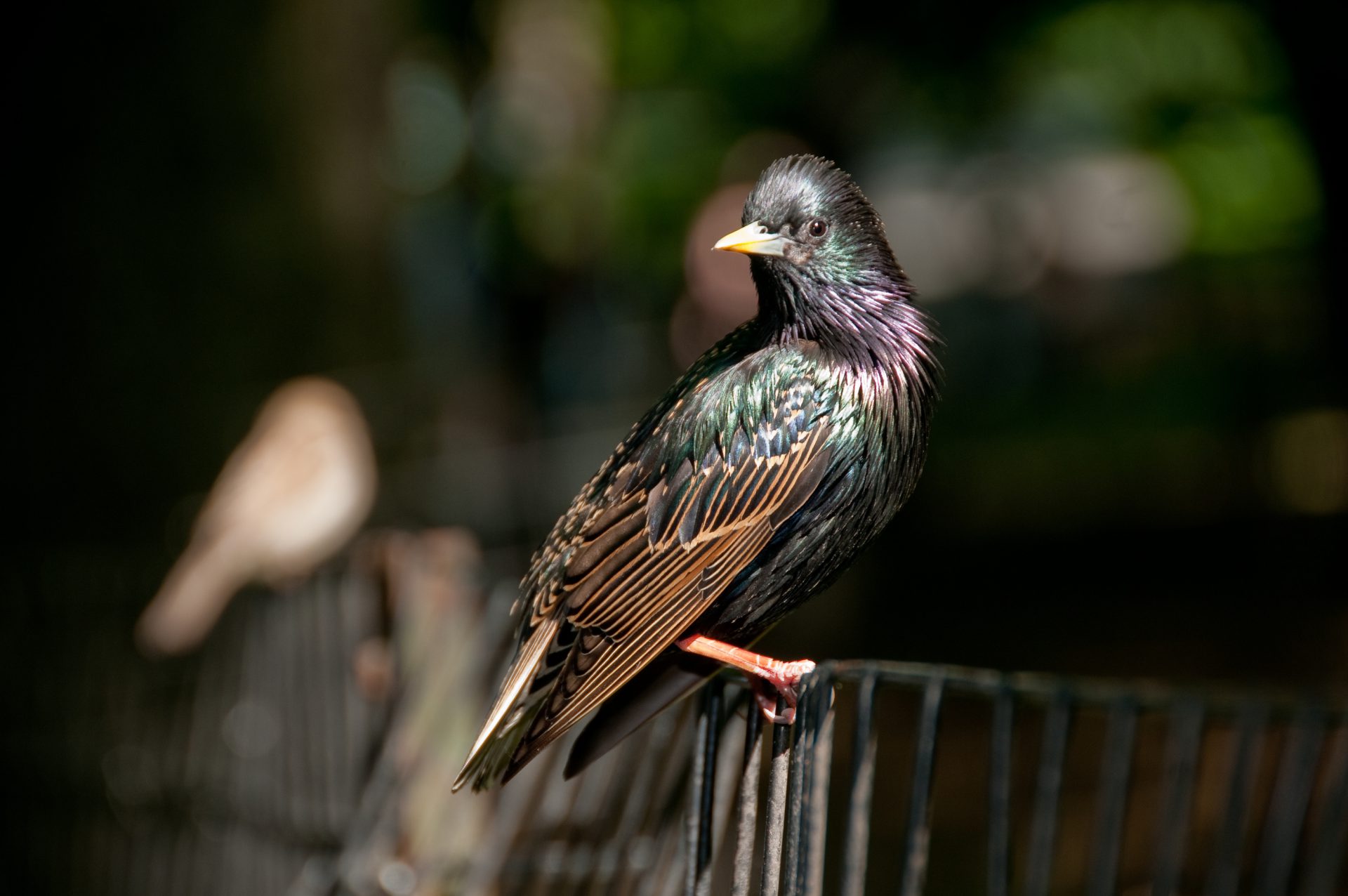Over the years we have received many wonderful questions about birds! Here are some great examples.
- Are birds smart?
- What did Birds evolve From?
- How do birds sing?
- Do all birds migrate?
- What should I do if I find an “abandoned” baby Killdeer, duckling or gosling?
- My cat doesn’t kill birds
- Birds sing for our benefit or because they are happy
Are birds smart?
Yes. Some scientists prefer not to call it “smart” but instead like to think that in order to survive birds have figured out how to do some pretty amazing things.
A few examples:
- Crows can make ‘tools’ to get food.
- Grackles are commonly seen taking hardened pieces of bread or dog food, putting them in water, and then eating them after they have softened.
- Blue Jays will imitate the calls of hawks. Maybe they do this to tell other jays that a hawk is around, or maybe they are deceiving other species into believing a hawk is present so they can get their food.
- A female Brown-headed Cowbird makes no nest of her own, but instead lays her eggs in the nests of other bird species, who then raise the young cowbirds.The female deposits as many as 40 eggs per year in nests that belong to other bird species. The female cowbird finds these nests by watching patiently. She typically chooses a nest with eggs smaller than her own and lays just one egg quickly at dawn once there are a few eggs in the nest. Cowbird nestlings are typically larger than their nest-mates and eat most of the food provided by the confused parents.
- Flocks of starlings fly skillfully. They appear to move as a single unit in a fluid dance, especially when avoiding predators or mobbing. The birds on the edges lead and can change directions instantly. It takes just 67 milliseconds for the first birds to react to a change in direction. It's like doing "the wave" at a football game, except that birds are much better at it than humans and they are flying at 30 miles per hour when they do it. Hawks become confused by a tightly packed flock.
- Some birds are thought to "play". Watch this video of ravens playing in the snow:

What did Birds evolve From?
This issue is actually still hotly debated among biologists and other scientists. While birds definitely evolved from reptiles, exactly which group of reptiles gave rise to birds remains a mystery and a motive for discussion. Current belief is that birds are descended from thecodonts, a reptile that existed 150 million years ago. Birds have been around for a pretty long time!
In 1861, a bird-like fossil named Archaeopteryx lithographica was discovered, providing the missing “link” needed to show this relationship between birds and reptiles. The first birds probably did not have feathers, but these structures actually developed pretty quickly. While they are of unknown origin, it is thought that birds first used them to keep a warm body temperature, for mating rituals, or to glide from one tree to the other.
If you would like to learn more about the origin of birds and their feathers, click here.
(back to top)How do birds sing?
Birds make tons of different sounds: chirps, rattles, whistles, trills, croaks, drumming, and many many more. But how do birds make these sounds? Well there are two categories of sounds: vocal and non-vocal sounds.
Vocal sounds are made by a special organ only birds possess: the syrinx. The syrinx is located at the very top of the birds' windpipe. The air that comes in through the windpipe causes thin membranes to vibrate and produce sound. The American Crow, one of our focal species, has one of the most developed syrinxes; this allows the crow to have a much greater variety of fine control over the sounds it makes! Unfortunately for us, many of these sounds are not musical to the human ear. One of this organ's many complexities, having two separate tracheal (windpipe) tubes, can cause a super cool phenomenon called "duetting" of songs where a bird can produce two separate sounds at once! You can listen to an example of a Wood Thrush "duetting" with itself here. Non-vocal sounds can be made by other parts of the bird such as the wings or the beak.
Do all birds migrate?
As the seasons change and winter comes and goes kids will inevitably ask the classic question of “Where do the animals go?” Birds are animals that can travel large distances during migration. But, do all birds migrate?
Not all birds migrate, but the majority of birds do. In fact, in North America about 75% of birds migrate. They do this for various reasons, for example, to find a more abundant source of food or a better climate.


The Baltimore Oriole, one of our focal species found along the east coast, migrates south in the winter. Its West Coast cousin, Bullock’s Oriole, also migrates south.
And, if a bird does not need to make a trip and is perfectly happy, where does it live? Well, these residents would be the other 25% of birds. They can live perfectly happy in the same environment all year round, like the beautiful Northern Cardinal.

What should I do if I find an “abandoned” baby Killdeer, duckling or gosling?
Baby Killdeer, like baby ducks, geese, and other fowl, are what we call "precocial chicks." These chicks hatch out of the egg covered with thick down, open their eyes quickly, and are perfectly capable of walking. Within minutes of hatching, they imprint on their parents and follow them tenaciously. Both parents show them food items, which they pick up and eat. The family unit stays together for several weeks.
Killdeer chicks grow rapidly, requiring huge amounts of food, but the chick you found has probably already imprinted on its parents and needs to be with them in order to recognize food and to eat.
The best thing to do is to bring the chick back and search for the adults. If you get anywhere near the rest of the family, one of the parents may give a broken-wing display, acting as if it's injured. You should set the chick down and leave as quickly as possible. It's sad to leave these adorable balls of fluff, but it's much sadder, for the bird as well as for you and/or your children, when it starves to death in your care.
If you don't know where a Killdeer chick was picked up, but do know where another Killdeer family is, with chicks close in size to the one you're dealing with, release it with that family. This also works in the case of ducklings and goslings.
For more information about helping baby ducks, geese, Killdeer, and other precocial chicks, try the Wildlife Rehabilitation Information Directory.
(back to top)My cat doesn’t kill birds
Cats kill more than two million birds every year (see a recent article by The New York Times on the subject). Chipmunks and mice also eat birds' eggs. Keep cats inside and if you put up a nest box make sure it has a predator-proof protector like an upside down shield on the pole below it. (check out NestWatch's page on how to deal with predators).
(back to top)Birds sing for our benefit or because they are happy
Birds will defend the territory around their nests by singing to signal their presence and by chasing other birds away. Birds don't sing to make us happy, they sing to attract a mate and defend their territory.
(back to top)